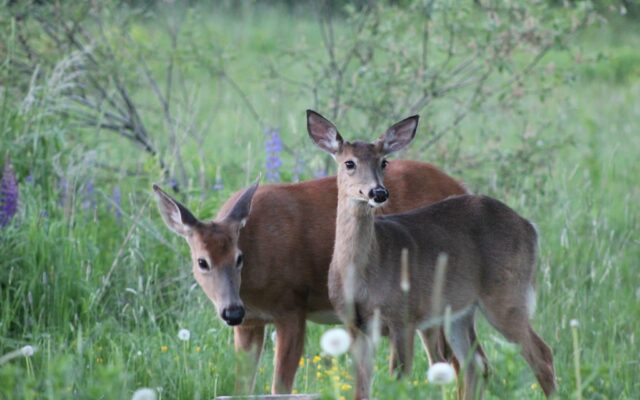
Early numbers from deer and bear seasons show near-record kills
By Julie Harris, Bangor Daily News Staff
Maine had near-record bear and deer seasons and a successful moose hunt in 2024, according to biologists from the Maine Department of Inland Fisheries and Wildlife who manage the state’s big game animals.
Preliminary numbers show that the deer kill was the second highest ever at 42,258, according to deer biologist Nathan Bieber. The bear kill was 3,787, the second highest in the past five years, and the moose hunt logged 2,608 cows and bulls out of the 4,105 permits issued, according to the state’s big game dashboard.
Maine’s big-game hunting seasons draw thousands of residents and out-of-state hunters to the woods, especially in the fall and late summer, adding more than $350 million to the state’s economy through licenses, equipment purchases, food, lodging and wages, according to Hunting Works for Maine, a partnership of about 100 businesses and organizations serving the hunting community.
Hunting for deer ended on Dec. 14, closing a season that began with expanded archery in early September, had two youth days and a month-long rifle and regular archery season before two weeks of muzzleloader hunting.
The highest deer kill in recent years was in 2023, at 43,787. Before that, the 1950s and 1960s were the last era in which the kill was in the 40,000s, Bieber said. There have only been seven years since the state has kept records that the kill was in that range, he said Friday.
He partially credited the healthy deer herd, the general good weather conditions, including on the state’s two youth hunting and season opening days, for the season’s success. The season was on track to set a record until Thanksgiving week brought in an unusually low number of animals for an unknown reason, Bieber said.
Some of his observations included that Wildlife Management Districts 15-17 and 20-25 seemed to have stable populations, meaning the number of deer was not too low or high; and there was a big increase in the bucks killed in WMDs 3 and 6, which are in northern Maine. The specific numbers are still being verified and tabulated.
Down East and Aroostook both had really good years, he said.
More bears were killed in 2024 than in 2023, mainly because there wasn’t as much food in the woods this year for the animals and they were drawn to bait sites, said Caitlin Drasher, the state’s bear biologist.
A preliminary total of 3,787 bears were killed this year, compared with 3,272 last year. The most killed in one year in the last 20 years was 3,883 in 2020. There were some years before 2005 in which about 3,900 were killed.
The season fluctuations are all about available food and hunter interest, Drasher said. In years when berries and hard mast such as acorns are less plentiful, bears tend to be more attracted to bait sites.
MDIF&W bear trapping education courses, a reduction in the bear license fee from $27 to $10 and people looking for new things to do during the pandemic all have contributed to an increase in the number of hunters, she said.
Although Drasher referred to this year as a pretty standard season, she said the number of bears taken by trapping increased from about 100 per season before COVID-19 to 318 in 2023 and 305 in 2024. The bear kill breaks down to 60-70 percent over bait, 20-25 percent with dogs and 5-10 percent by trapping, Drasher said.
It was a good year for moose hunters, state moose biologist Lee Kantar said. The good fall weather, with not many hot temperatures, contributed to the successful hunt.
Preliminary numbers show 2024 to be tied for the fourth highest number of moose killed in 20 seasons at 2,608. That number could change after the data is verified, he said.
Although the bull and cow kills in the hunt’s first and third weeks, respectively, were similar to last year, the bull hunt in October was up 10 percent, Kantar said.
The moose hunt is consistent from year to year overall, but there can be variations in individual wildlife management districts, he said.
“Hunting is a whole experience,” he said, pointing out that it’s not just about shooting an animal. “There’s the planning, the anticipation, the hunt, then talking about it afterward and enjoying the meat with your family.”
Maine’s biologists have their eyes open for future issues that could affect the animals’ populations. Bieber said that chronic wasting disease was found in a captive deer in New York State, and that although Maine has not seen the disease yet, he will keep a watchful eye on the situation.
Maine’s bear population is very healthy, but Drasher is watching the western United States where avian influenza has killed a handful of black bears. She said no testing has been done on Maine’s black bears but any found dead from a cause that isn’t obvious will be tested.
Most bears have already denned up for the season, including all of the animals the department follows for research, even though it’s been warm, she said. Bears are driven to their dens earlier when the food supply is not as great.
Moose biologist Kantar has already started surveying WMD 4 from the air in preparation for his annual trip to put electronic collars on “short yearlings” — moose calves that are not quite a year old — to track mortality from winter ticks.
This will be the 12th year of the program. Moose deaths from winter ticks have declined in the last couple of years.